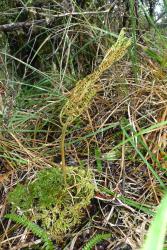- = Sceptridium Lyon, Bot. Gaz. 40: 457 (1905)
Terrestrial ferns. Rhizomes erect, glabrous; roots thick and fleshy, contractile in some species, sometimes bearing vegetative buds or gemmae (not NZ), but not proliferous. Fronds circinate, divided into a sterile photosynthetic blade and a reduced spore-bearing portion (sporophore), 1 or 2 produced per season. Common stalk glabrous or bearing scattered hairs. Sterile blade divided 1–several times, herbaceous or coriaceous, glabrous or bearing scattered hairs. Veins free. Sporophore divided 1–several times. Sporangia not in sori, sessile or subsessile, clustered on branches of the divided sporophore. Spores trilete, cream to yellow, coarsely to finely verrucate.
A genus of 50–60 species (Wagner & Wagner 1993). Botrychium was monographed by Clausen (1938) but many more species have since been recognised, particularly in North America (see Wagner & Wagner 1993). The genus in New Zealand was revised by Braggins (1980) who recognised three species.
Wagner (1990) recognised four subgenera – Osmundopteris, Japanobotrychium, Sceptridium and Botrychium. New Zealand species belong to the latter two, which are sometimes raised to generic rank.
| 1 | Sterile blade of frond 1-pinnate; stalk of sporophore 3–30 mm long | lunaria |
| Sterile blade of frond divided several times; stalk of sporophore 37–420 mm long | 2 | |
| 2 | Sterile blade divided 3–5 times; ultimate segments acute or obtuse, 1.3–5 mm wide; roots often contractile | australe |
| Sterile blade divided 5–7 times; ultimate segments acuminate, 0.2–1 mm wide; roots not contractile | biforme |
Botrychium is recognised by its fronds, which comprise a dissected sterile blade with free veins and a branched sporophore. The sporangia are sessile or subsessile and exposed on the branches of the sporophore. By contrast, Ophioglossum has an entire sterile blade with reticulate veins and an undivided fertile sporophore with sunken sporangia.
Mostly distributed in temperate and polar regions but also extending to mountains of the tropics, with the greatest diversity in North America and Asia; many species are rare and local (Wagner 1990). Two species in Australia (Chinnock 1998), one in the tropical Pacific and another (probably extinct) in Hawai‘i (Palmer 2003), three in temperate South America, 30 in North America (Wagner & Wagner 1993) and 12 in China (Zhang et al. 2013). Three species in New Zealand; one endemic.
| Category | Number |
|---|---|
| Indigenous (Endemic) | 1 |
| Indigenous (Non-endemic) | 2 |
| Total | 3 |
The base chromosome number in Botrychium is x = 45 (Wagner 1990).
The occurrence of underground gemmae on the roots and rhizomes of some North American species of Botrychium was first reported by Farrar & Johnson-Groh (1990). Similar vegetative propagules have not yet been observed in New Zealand species.




